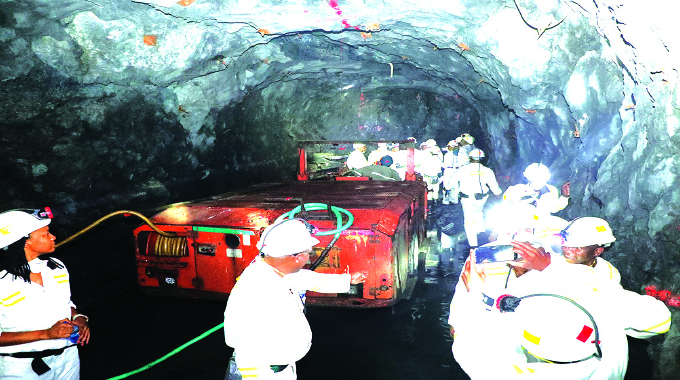EDITORIAL COMMENT: Fisheries need to be developed, maximised

Fisheries appear to be an undeveloped resource in Zimbabwe, which means we must not only make better use of the water resources we already have, but also build the fisheries and develop the required underlying ecologies in the many new dams the Second Republic is building.
Zimbabwe has very little in the way of natural lakes, almost nothing to be precise, but there are considerable bodies of water on most major rivers now resulting from the construction of dams impounding water for hydro-power, irrigation and urban water supplies and while fish are caught in all these man-made lakes, and Lake Kariba the largest has a well-developed commercial fishery, we need to make more use of all that water.
This week saw the launch of the Lake Kariba Inshore Fisheries Management Plan, which is a determined effort to upgrade easily the largest fishery in the country, ensure that it achieves maximum sustainable output, and controls the poaching, illegal fishing in protected breeding areas and the like.
There appears to be still the problem of multiple mandates. The plan comes through the Ministry of Environment, Climate, Tourism and Hospitality Industry, working with ZimParks who need to enforce licencing.
We also have the Ministry of Lands, Agriculture, Fisheries, Water and Rural Development.
While almost every economic activity involves more than one Ministry, this usually means that there needs to be good co-ordination between all involved, so all the bits fit together.
Lake Kariba has had a mature and stable ecology for several decades now. There are fluctuations in water levels, from a high in mid-year when the Angolan flood waters are impounded, down to the bottom level at year end when much of the stored flood water is used up and the inflows from north-west Zimbabwe and south central Zambia are only starting to build up.
But these are not that dramatic for the ecology, although obviously are for power stations.
There have been reports of major fluctuations in fish catches, and reports that there is growing illegal fishing, especially in the estuaries of the smaller rivers flowing into the lake where many species breed and which are supposed to be kept clear of fishing, at least in the breeding seasons.
Research probably needs to be increased, to see where stresses occur. For example the whole food chain might rely on reasonable quantities of particular species at a particular rung of that ladder, and we can find there is overfishing there that limits catches higher up the food chain.
Hopefully the new plan will be addressing these sort of issues and be involving the required practical research among ecologists, environmental scientists and fish experts, again all working as a team, to find the deficiencies, the limits and the bottlenecks.
At the same time we need more progress in developing commercial fishing in our many irrigation and water-supply dams.
Although these dams are all much smaller than Lake Kariba, this is just when they are compared with that giant storage lake. Some of the dams we are talking about are in fact very large when looked at in absolute terms.
While when it comes to irrigation and water supply the volume behind the dam wall is important, for fisheries the surface area is almost always the more critical factor, along with water quality.
So large shallow lakes will see far more fluctuations in area as water is used for irrigation and urban supplies than deeper lakes where most of the seasonal fluctuation is in depth.
As part of the Government policy of spreading wealth, as well as creating wealth, fisheries need to include the fishing villages, the co-operative ventures and the like, as well as the large commercial fish companies.
This has been achieved in much of farming since land reform, with the processors of agricultural produce having links to the full range of farmers, from the smallest to the largest and everyone else in between.
Fish processing companies, the firms that will process and freeze fish, or even just gut and dry fish, or just sell what the fisher villages have caught and processed, can build up these same sort of links.
They do not have to catch themselves everything they sell. We can follow the same route that tobacco, cotton, grains, sugar and oil seeds have followed and are still developing so everyone is included.
But there are needs for quality control, and health control, and managing a new ecology as efficiently as possible to maximise sustainable catches.
For example it is easy to buy fish caught in Lake Chivero by a lot of single fishers, who co-operate very little.
One problem is that lake has a lot of pollution, and it is not possible to find out if any fish caught there is healthy, considering that each fisher does most of their own marketing.
We now have new big dams settling down and stable ecologies forming, although with not much research into introducing new species of fish, or new varieties.
Many of these dams just contain fish that were in the river that has been dammed, and while many fish that swim in rivers can flourish in a dammed lake, there are others that cannot survive well in a river, but which can provide the source of food and money when in a lake.
Introducing species requires a great deal of thought, since there can be problems as well as benefits and obviously the benefits must significantly outweigh the problems, and the problems need to be soluble.
We have seen problems of water hyacinth and other introductions that can really cause serious difficulties, and the introduction of Nile Perch into some of the East African Great Lakes has seen what have been described as ecological disasters.
Zimbabwe has been stressing practical and innovative research, and we think that the fishing industry can use this, across a wide range of activity.
Besides having the right fish, and working out efficient breeding and the like, we perhaps need to look at the sort of technology fishing villages need to catch the right sort of fish of the right size, with minimal by-catch and zero catches of immature fish.
A lot of this just required co-ordinated and sustained effort, as we have been doing with so much else that we have been handling as we push development and open new and real opportunities for the majority of our people to earn a decent living from that development.










Comments